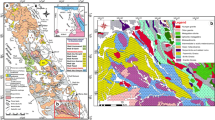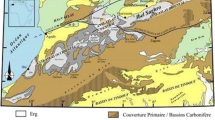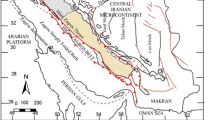Abstract
Hydrothermal alteration mineral zones associated with porphyry copper mineralization can be identified and discriminated based on distinctive spectral properties of the ASTER satellite data. Image processing techniques are mostly used for regional scale mapping but in this study, we aimed to evaluate them for more detailed exploration studies by fusing ASTER and QuickBird-2 satellite data using Gram-Schmidt sharpening method to enhance the spatial resolution of the imagery. Selective principal component analysis (PCA) technique is used to provide mineral distribution maps from the spatially improved ASTER data. PCA was applied to ASTER bands with the objective of mapping the occurrence of mineral end-members related to a porphyry copper deposit named Naysian in Iran. The results illustrate the ability of ASTER data for extracting information on alteration minerals which are valuable for mineral exploration studies and support the role of PCA as a very robust image processing technique for that purpose. The spatial distribution of hydrothermal alteration zones has been verified by insitu field observations. This investigation indicated that applying image processing techniques has a great ability to obtain significant and comprehensive information in detailed stages of porphyry copper deposit exploration at a local scale. The results of this research can assist exploration geologists to make a better planning for more detailed stages of exploring porphyry copper and even gold deposits in other virgin regions before costly detailed ground investigations. Consequently, the introduced image processing approach can present an optimum idea about the application of remote sensing in final stages of mineral exploration.










Similar content being viewed by others
References
Abrams, M. (2000). The Advanced Spaceborne Thermal Emission and Reflection Radiometer (ASTER): data products for the high spatial resolution imager on NASA’s Terra platform. International Journal of Remote Sensing, 21(5), 847–859.
Afzal, P., Khakzad, A., Moarefvand, P., Omran, N. R., Esfandiari, B., & Alghalandis, Y. F. (2010). Geochemical anomaly separation by multifractal modeling in Kahang (Gor Gor) porphyry system, Central Iran. Journal of Geochemical Exploration, 104(1), 34–46.
Alavi, M. (1994). Tectonics of the Zagros orogenic belt of Iran: new data and interpretations. Tectonophysics, 229(3), 211–238.
Bedini, E., Van Der Meer, F., & Van Ruitenbeek, F. (2009). Use of HyMap imaging spectrometer data to map mineralogy in the Rodalquilar caldera, southeast Spain. International Journal of Remote Sensing, 30(2), 327–348.
Ben-Dor, E., Kruse, F. A., Lefkoff, A. B., & Banin, A. (1994). Comparison of three calibration techniques for utilization of GER 63-channel aircraft scanner data of Makhtesh Ramon, Negev, Israel. Photogrammetric Engineering and Remote Sensing, 60(11), 1339–1354.
Berberian, M., & King, G. C. P. (1981). Towards a paleogeography and tectonic evolution of Iran. Canadian Journal of Earth Sciences, 18(2), 210–265.
Clark, R. N., Swayze, G. A., Wise, R., Livo, E., Hoefen, T., Kokaly, R., & Sutley, S. J. (2007). USGS digital spectral library splib06a. U.S. Geological Survey.
Crosta, A., & Moore, J. (1990). Enhancement of Landsat Thematic Mapper imagery for residual soil mapping in SW Minas Gerais State, Brazil- A prospecting case history in greenstone belt terrain. In Thematic conference on remote sensing for exploration geology- methods, integration, solutions (pp. 1173–1187).
Crosta, A. P., De Souza Filho, C. R., Azevedo, F., & Brodie, C. (2003). Targeting key alteration minerals in epithermal deposits in Patagonia, Argentina, using ASTER imagery and principal component analysis. International Journal of Remote Sensing, 24(21), 4233–4240.
Digital Globe (2013). QuickBird data sheet.
Gabr, S., Ghulam, A., & Kusky, T. (2010). Detecting areas of high-potential gold mineralization using ASTER data. Ore Geology Reviews, 38(1), 59–69.
Gersman, R., Ben‐Dor, E., Beyth, M., Avigad, D., Abraha, M., & Kibreab, A. (2008). Mapping of hydrothermally altered rocks by the EO‐1 Hyperion sensor, Northern Danakil Depression, Eritrea. International Journal of Remote Sensing, 29(13), 3911–3936.
Hedenquist, J. W., & Lowenstern, J. B. (1994). The role of magmas in the formation of hydrothermal ore deposits. Nature, 370(6490), 519–527.
Hewson, R. D., Cudahy, T. J., Mizuhiko, S., Ueda, K., & Mauger, A. J. (2005). Seamless geological map generation using ASTER in the Broken Hill-Curnamona province of Australia. Remote Sensing of Environment, 99(1), 159–172.
Hunt, G. R. (1977). Spectral signatures of particulate minerals in the visible and near infrared. Geophysics, 42(3), 501–513.
Hunt, G. R., & Ashley, R. P. (1979). Spectra of altered rocks in the visible and near infrared. Economic Geology, 74(7), 1613–1629.
John, D. A., Ayuso, R. A., Barton, M. D., Blakely, R. J., Bodnar, R. J., Dilles, J. H., Gray, F., Graybeal, F. T., Mars, J. C., McPhee, D. K., Seal, R. R., Taylor, R. D., & Vikre, P. G. (2010). Porphyry copper deposit model, chap. B of Mineral deposit models for resource assessment. (pp. 169): U.S. Geological Survey Scientific Investigations Report 2010–5070–B.
Kargi, H. (2007). Principal components analysis for borate mapping. International Journal of Remote Sensing, 28(8), 1805–1817.
Laben, C. A., & Brower, B. V. (2000). Process for enhancing the spatial resolution of multispectral imagery using pan-sharpening. U.S.
Linhai Jing, Q. C., & Panahi, A. (2006). Principal component analysis with optimum order sample correlation coefficient for image enhancement. International Journal of Remote Sensing, 27(16), 3387–3401.
Loughlin, W. P. (1991). Principal component analysis for alteration mapping. Photogrammetric Engineering and Remote Sensing, 57(9), 1163–1169.
Mars, J. C., & Rowan, L. C. (2006). Regional mapping of phyllic-and argillic-altered rocks in the Zagros magmatic arc, Iran, using Advanced Spaceborne Thermal Emission and Reflection Radiometer (ASTER) data and logical operator algorithms. Geosphere, 2(3), 161–186.
Mokhtari, Z., Boomeri, M., & Bagheri, S. (2015). Digital image processing and analysis techniques for detection of hydrothermal alteration zones: a case study in Siah-Jangal area, North of Taftan Volcano, Southeastern Iran. Journal of the Indian Society of Remote Sensing, 43(2), 363–377.
Moore, F., Rastmanesh, F., Asadi, H., & Modabberi, S. (2008). Mapping mineralogical alteration using principal‐component analysis and matched filter processing in the Takab area, north‐west Iran, from ASTER data. International Journal of Remote Sensing, 29(10), 2851–2867.
Ninomiya, Y. (2003a). A stabilized vegetation index and several mineralogic indices defined for ASTER VNIR and SWIR data. In Geoscience and remote sensing symposium (Vol. 3, pp. 1552–1554).
Ninomiya, Y. (2003b). Advanced remote lithologic mapping in ophiolite zone with ASTER multispectral thermal infrared data. In Geoscience and remote sensing symposium (Vol. 3, pp. 1561-1563).
Pour, A. B., & Hashim, M. (2011). Identification of hydrothermal alteration minerals for exploring of porphyry copper deposit using ASTER data, SE Iran. Journal of Asian Earth Sciences, 42(6), 1309–1323.
Pour, A. B., & Hashim, M. (2012). The application of ASTER remote sensing data to porphyry copper and epithermal gold deposits. Ore Geology Reviews, 44, 1–9.
Richards, J. P., Wilkinson, D., & Ullrich, T. (2006). Geology of the Sari Gunay epithermal gold deposit, northwest Iran. Economic Geology, 101(8), 1455--1496.
Rockwell, B. W., & Hofstra, A. H. (2008). Identification of quartz and carbonate minerals across northern Nevada using ASTER thermal infrared emissivity data—Implications for geologic mapping and mineral resource investigations in well-studied and frontier areas. Geosphere, 4(1), 218–246.
Rowan, L. C., & Mars, J. C. (2003). Lithologic mapping in the Mountain Pass, California area using advanced spaceborne thermal emission and reflection radiometer (ASTER) data. Remote Sensing of Environment, 84(3), 350–366.
Rowan, L. C., Schmidt, R. G., & Mars, J. C. (2006). Distribution of hydrothermally altered rocks in the Reko Diq, Pakistan mineralized area based on spectral analysis of ASTER data. Remote Sensing of Environment, 104(1), 74–87.
Shahabpour, J. (1994). Post-mineralization breccia dike from the Sar Cheshmeh porphyry copper deposit, Kerman, Iran. Exploration and Mining Geology, 3(1), 39–43.
Stocklin, J. (1977). Structural correlation of the Alpine ranges between Iran and Central Asia. Memoire Hors-Serve, 8, 333–353.
Xu, Y., Lin, Q., Shao, Y., & Wang, L. (2004). Extraction mechanism of alteration zones using ASTER imagery. In Geoscience and remote sensing symposium (Vol. 6, pp. 4174–4175).
Yamaguchi, Y., Fujisada, H., Kudoh, M., Kawakami, T., Tsu, H., Kahle, A. B., & Pniel, M. (1999). ASTER instrument characterization and operation scenario. Advances in Space Research, 23(8), 1415–1424.
Yamaguchi, Y., & Naito, C. (2003). Spectral indices for lithologic discrimination and mapping by using the ASTER SWIR bands. International Journal of Remote Sensing, 24(22), 4311--4323.
Author information
Authors and Affiliations
Corresponding author
About this article
Cite this article
Farahbakhsh, E., Shirmard, H., Bahroudi, A. et al. Fusing ASTER and QuickBird-2 Satellite Data for Detailed Investigation of Porphyry Copper Deposits Using PCA; Case Study of Naysian Deposit, Iran. J Indian Soc Remote Sens 44, 525–537 (2016). https://doi.org/10.1007/s12524-015-0516-7
Received:
Accepted:
Published:
Issue Date:
DOI: https://doi.org/10.1007/s12524-015-0516-7




